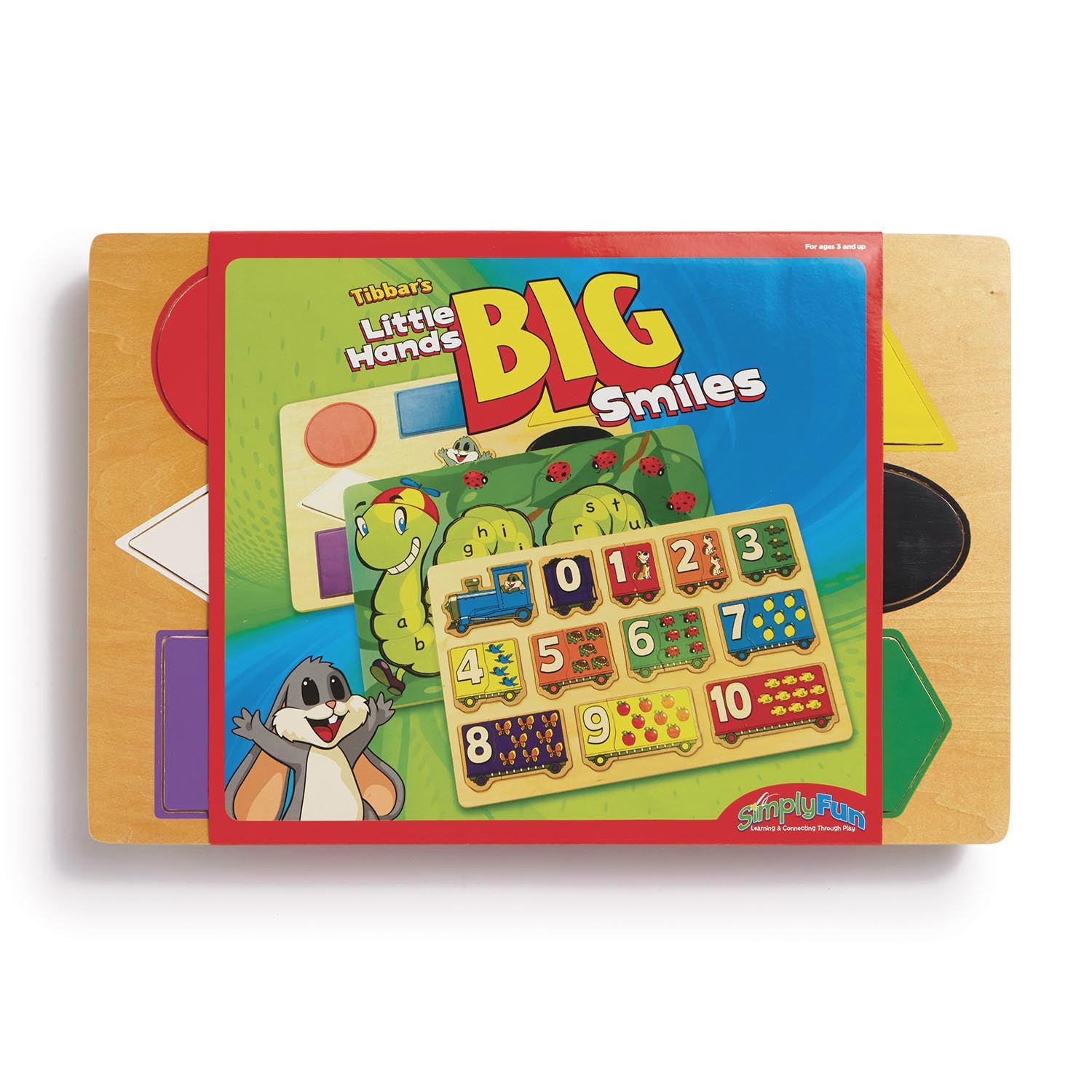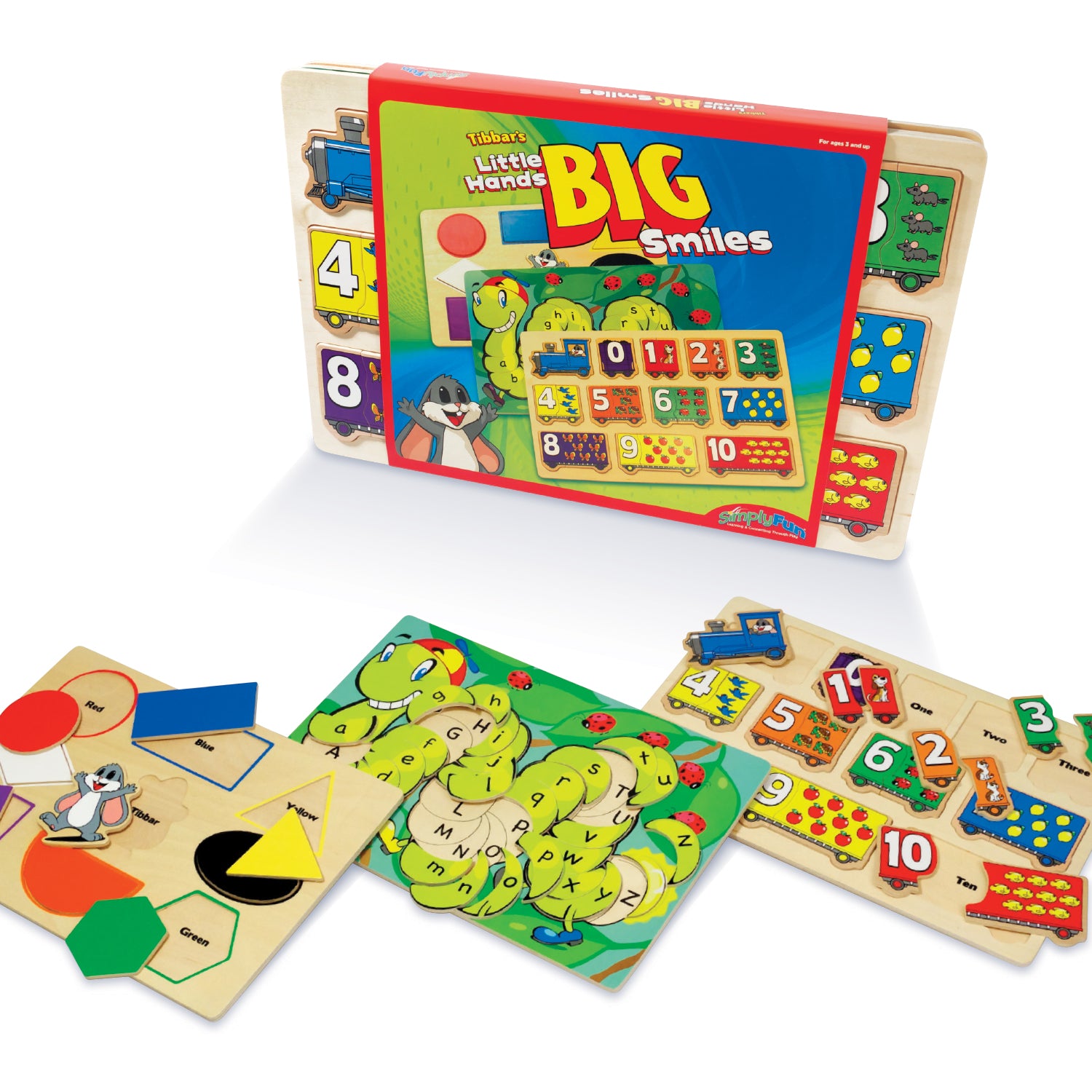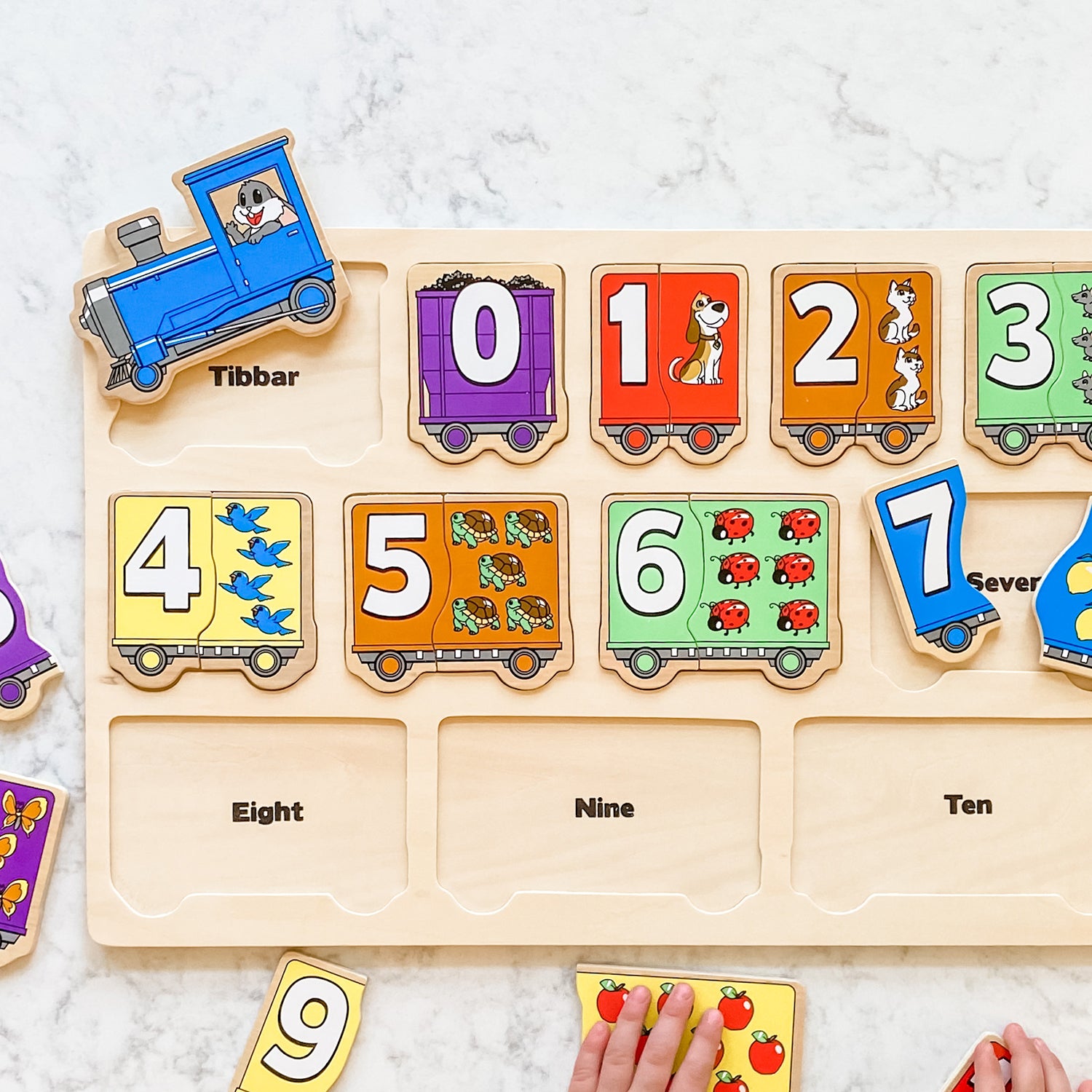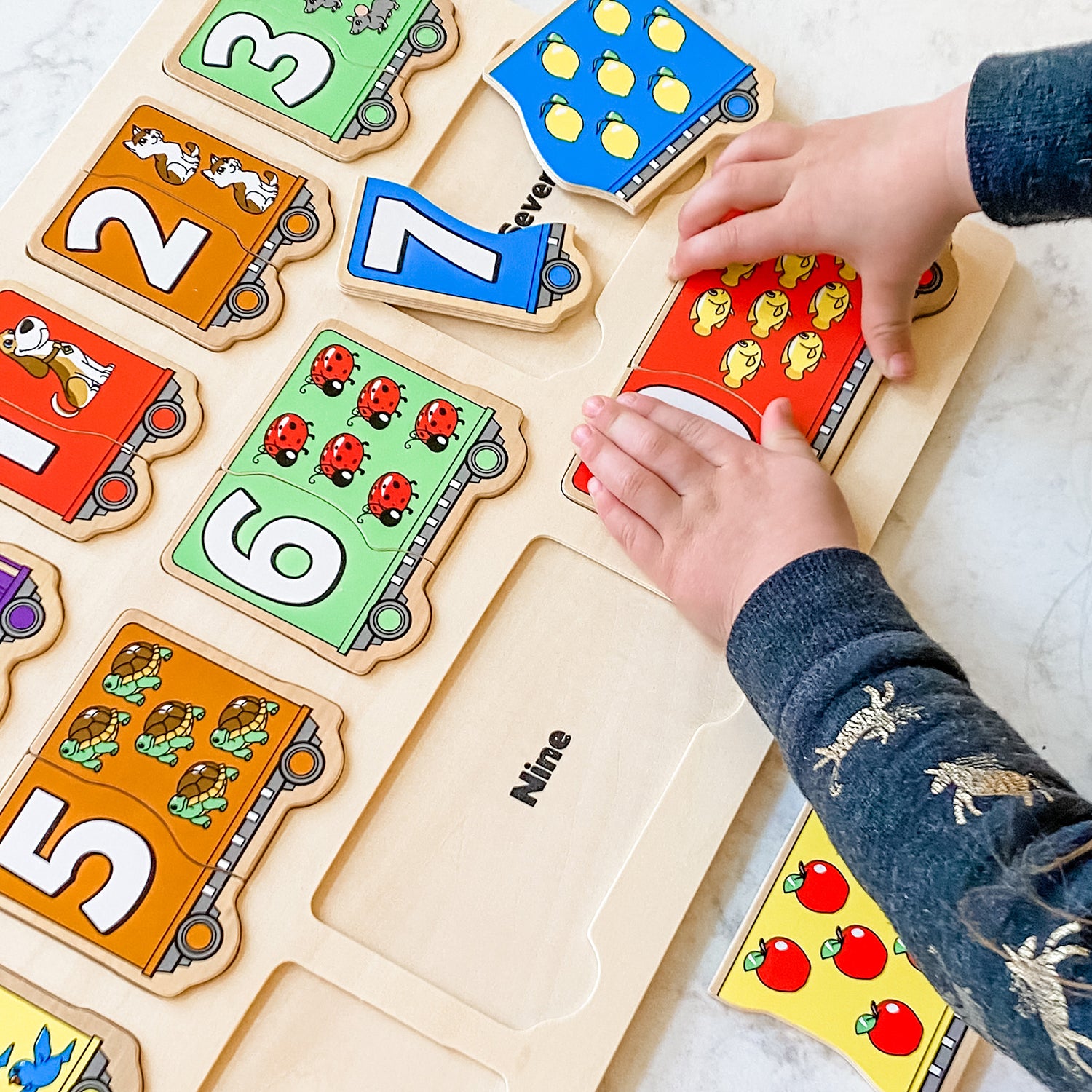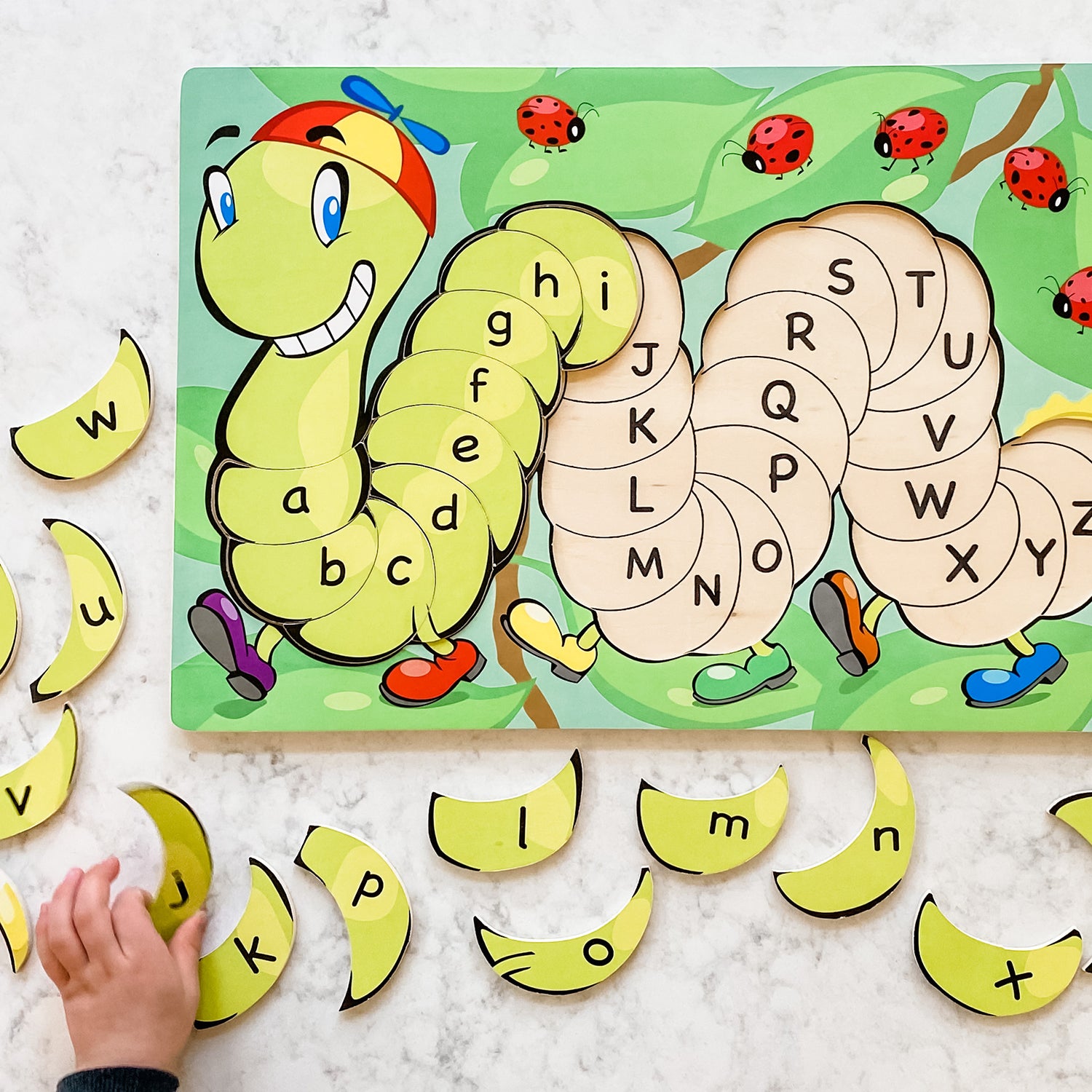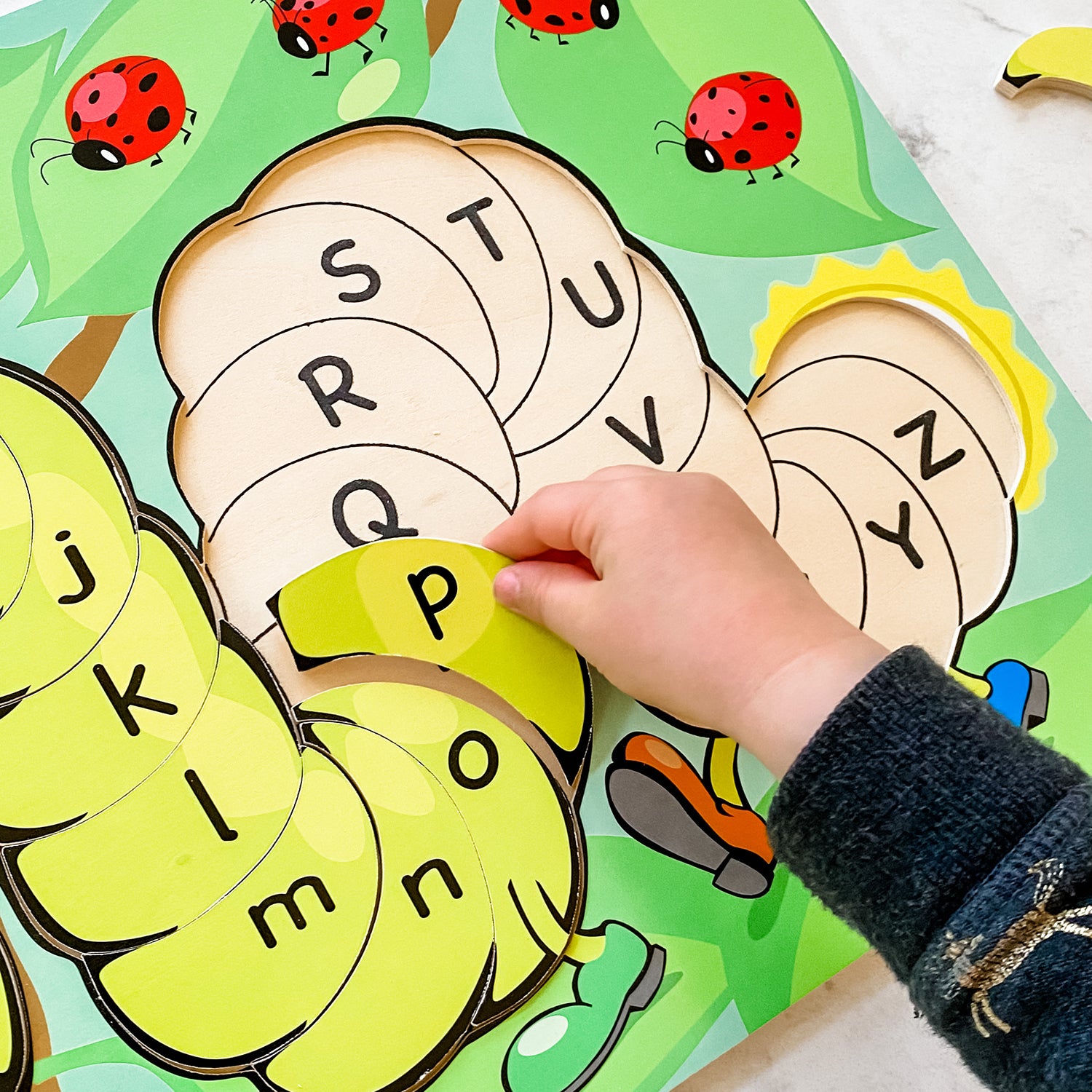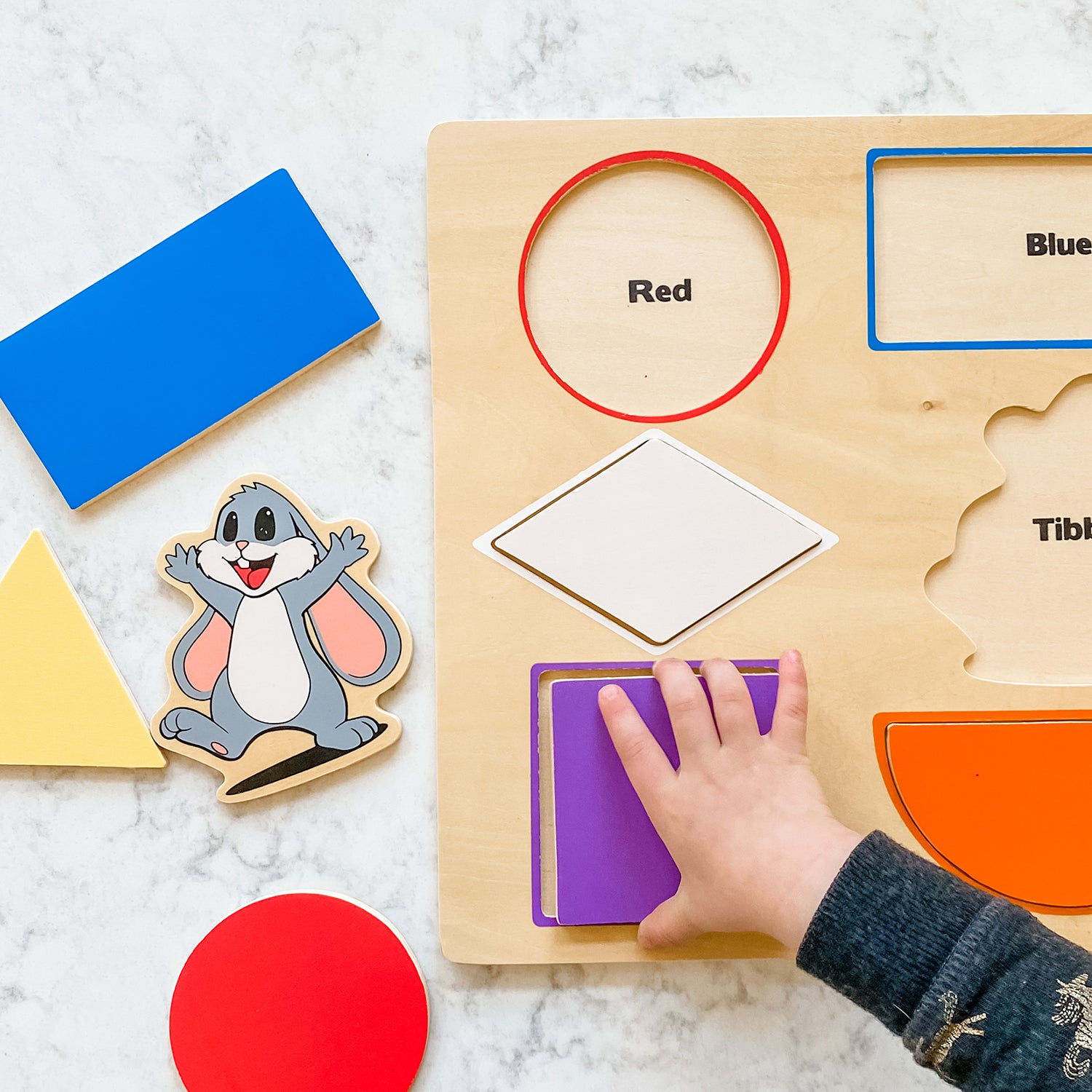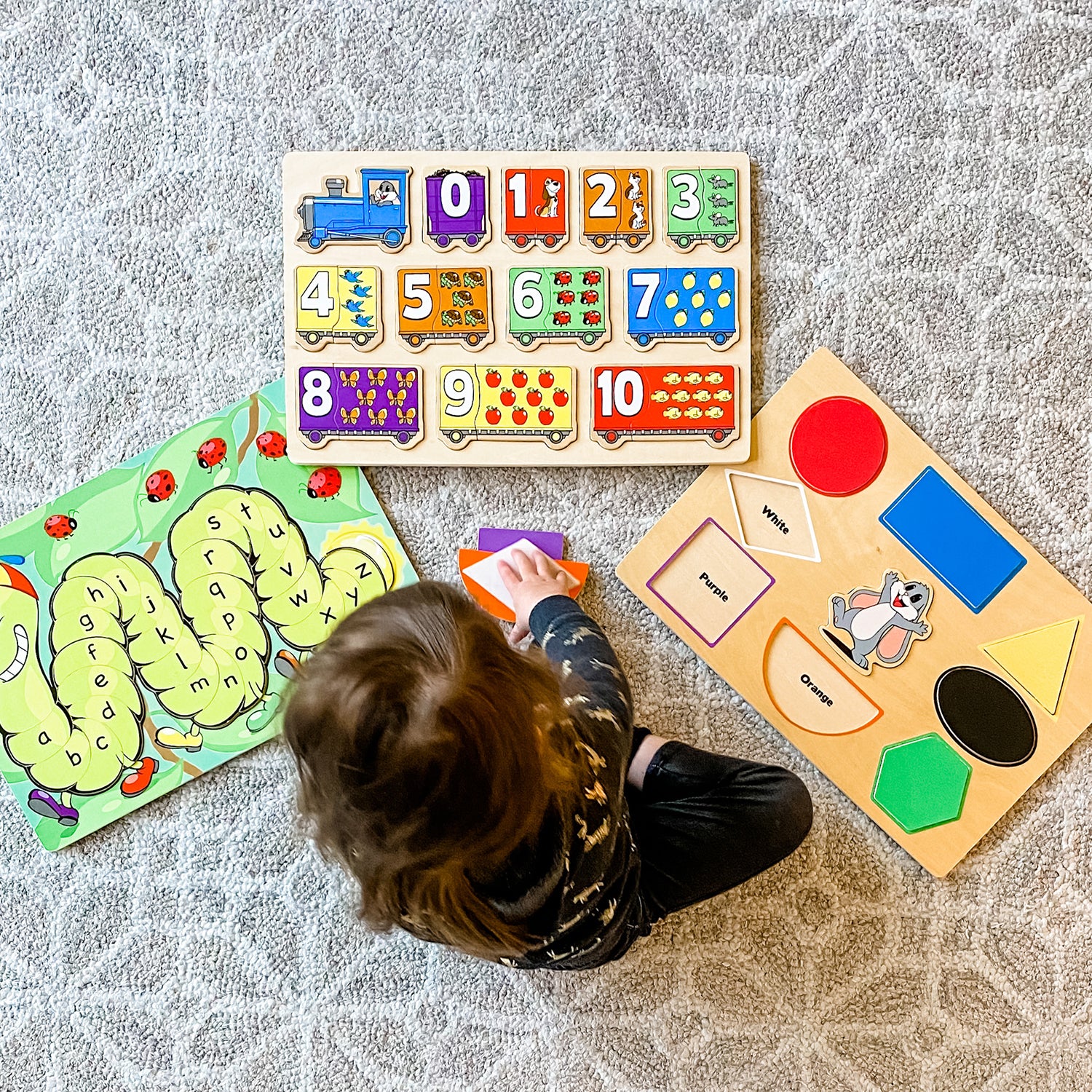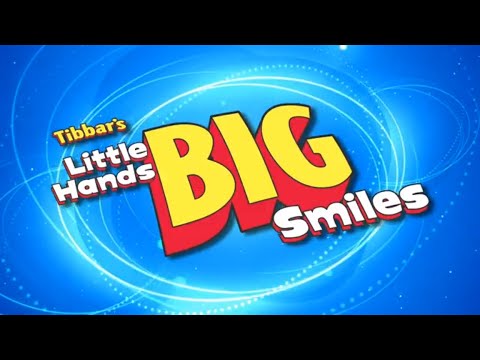Tibbar's Little Hands, Big Smiles
Tibbar's Little Hands, Big Smiles
3 & up
Focus: Shapes & Letters
Couldn't load pickup availability
Shapes? Check! Colors? Check! Alphabet? Check! Numbers and counting? Check, check! This three-puzzle pack not only helps your child grow but also grows along with them. Each puzzle measures 17 3/4" x 11 3/4"
Skills: Shapes, Colors, Lowercase & Uppercase Letters, Counting
Game Includes
Game Includes
- Huey Alphabet Puzzle
- Tibbar's First Shapes and Colors Puzzle
- Tibbar's Number Train Puzzle
Share
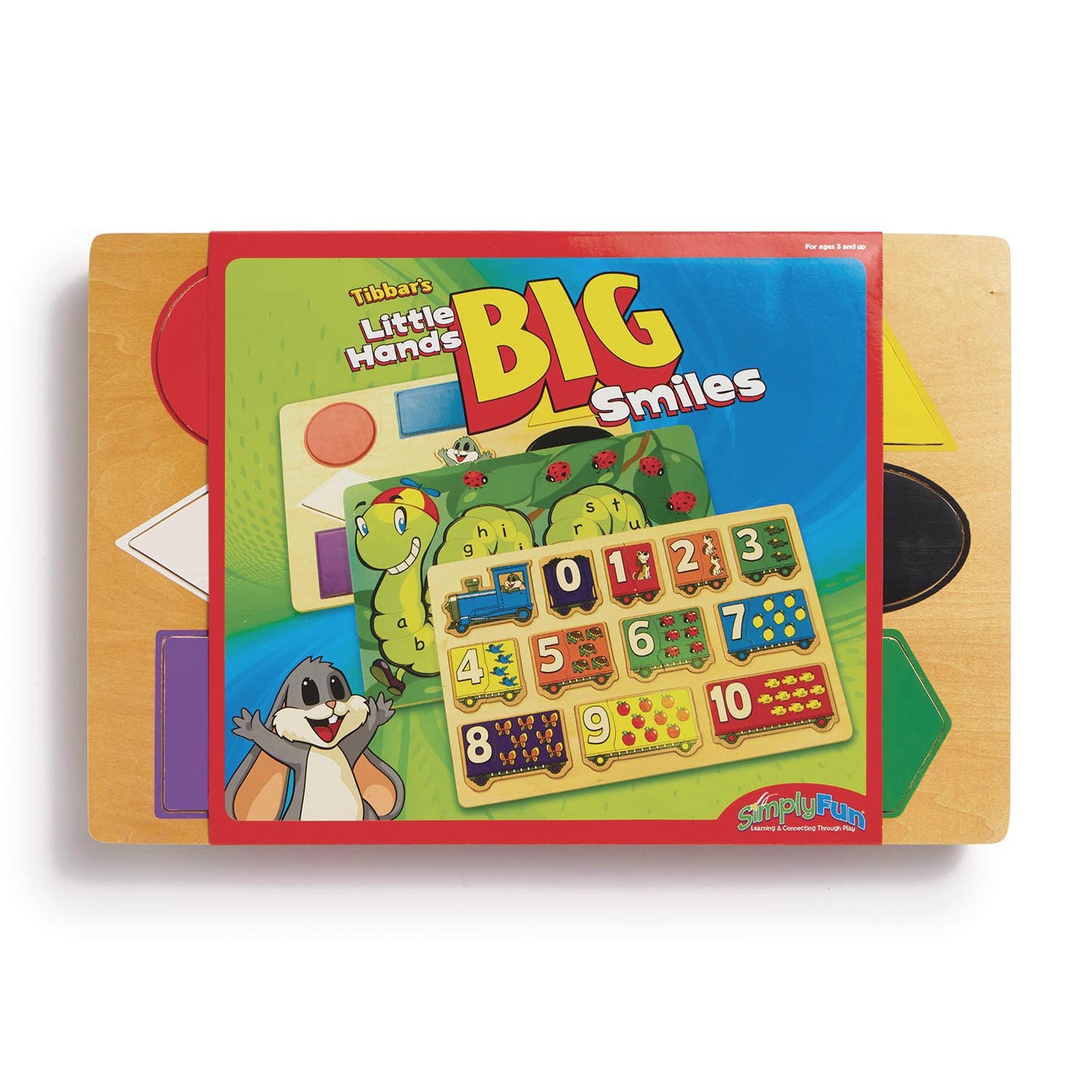
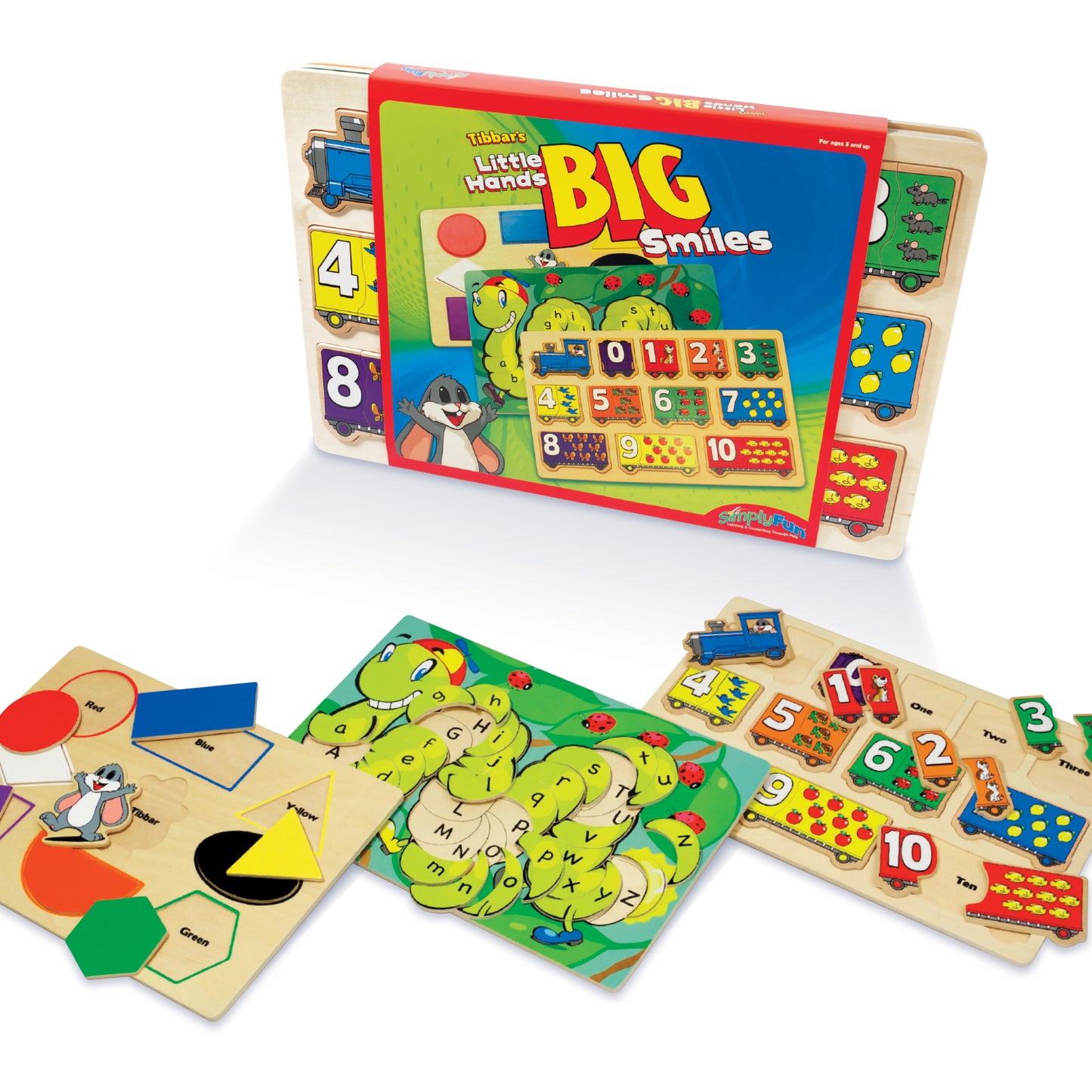
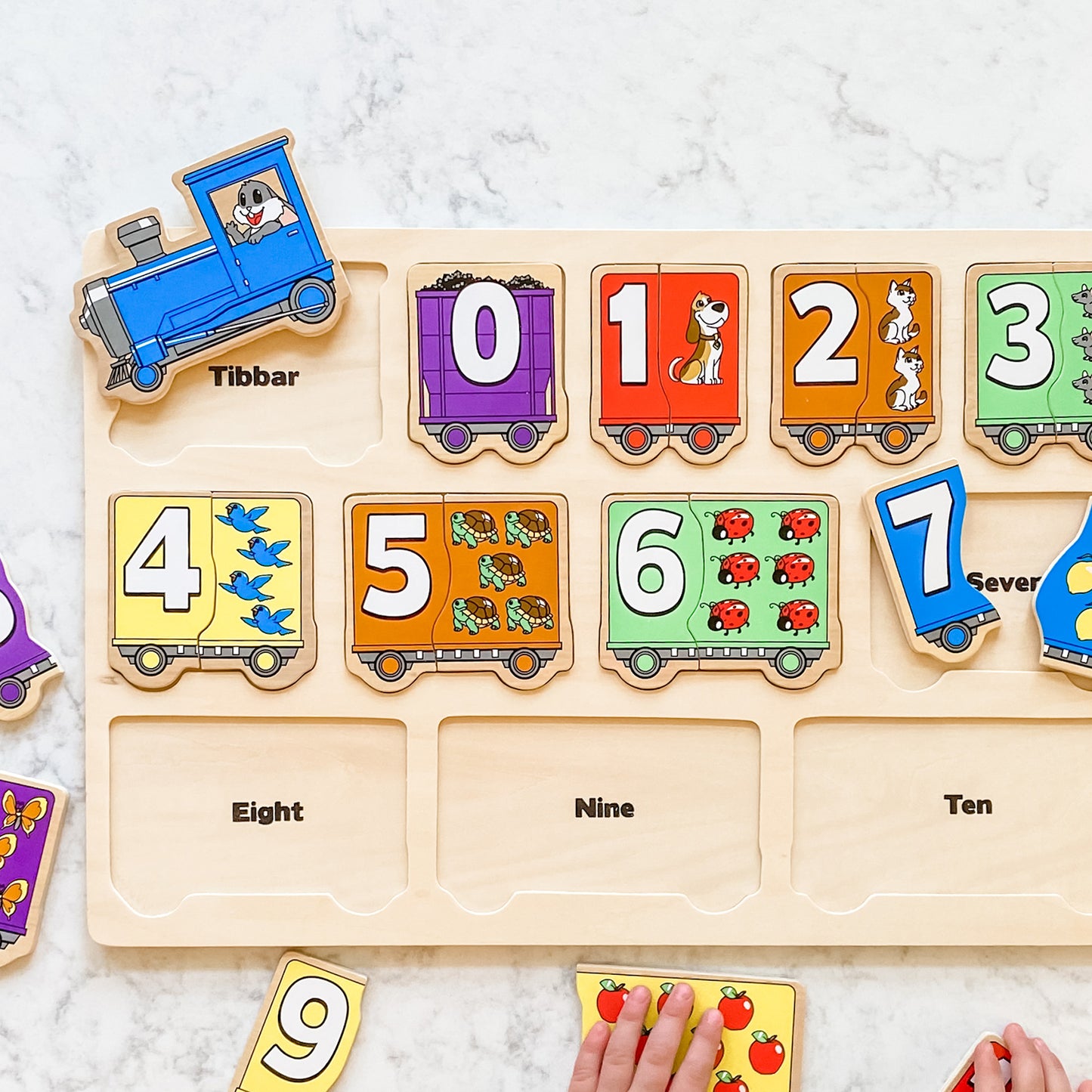
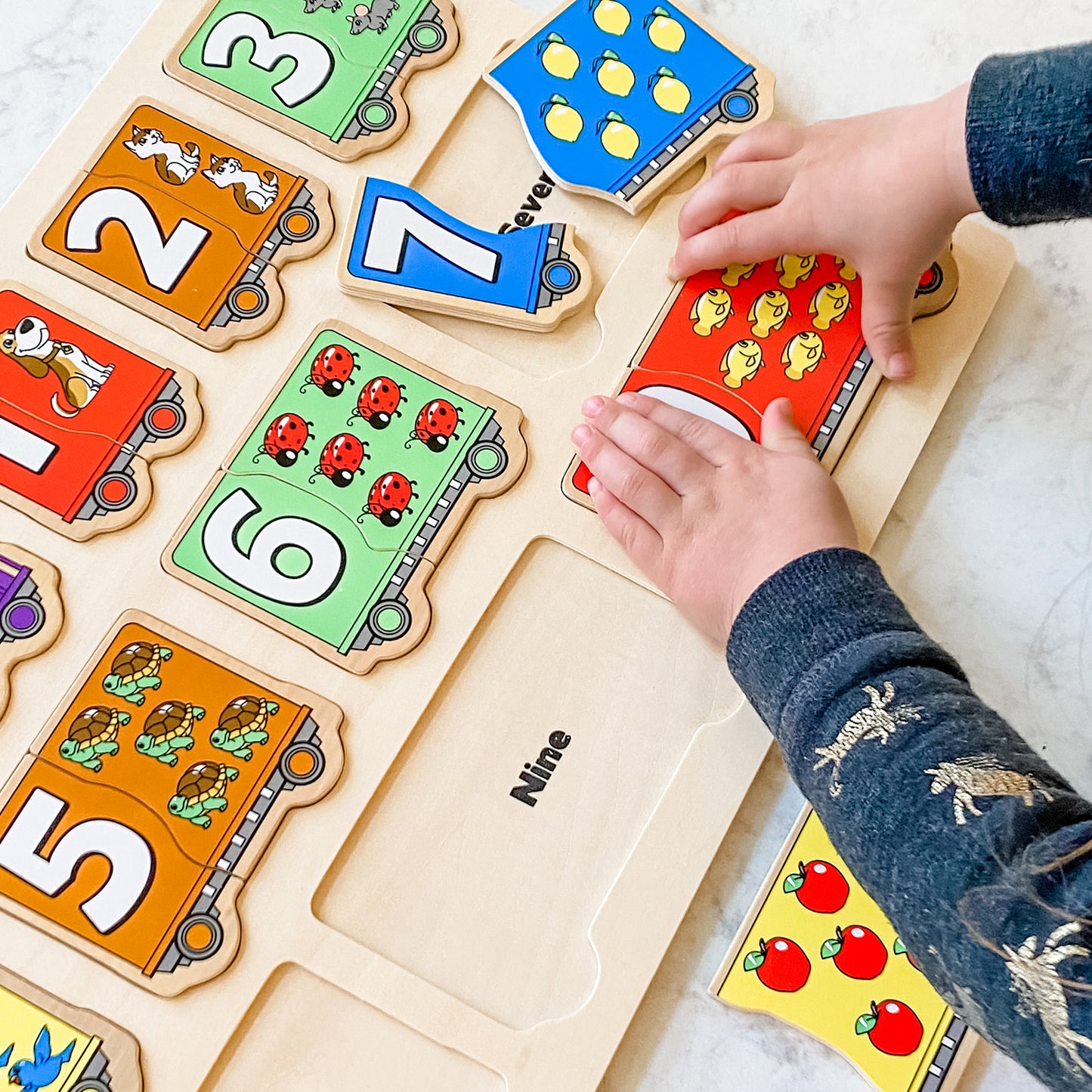
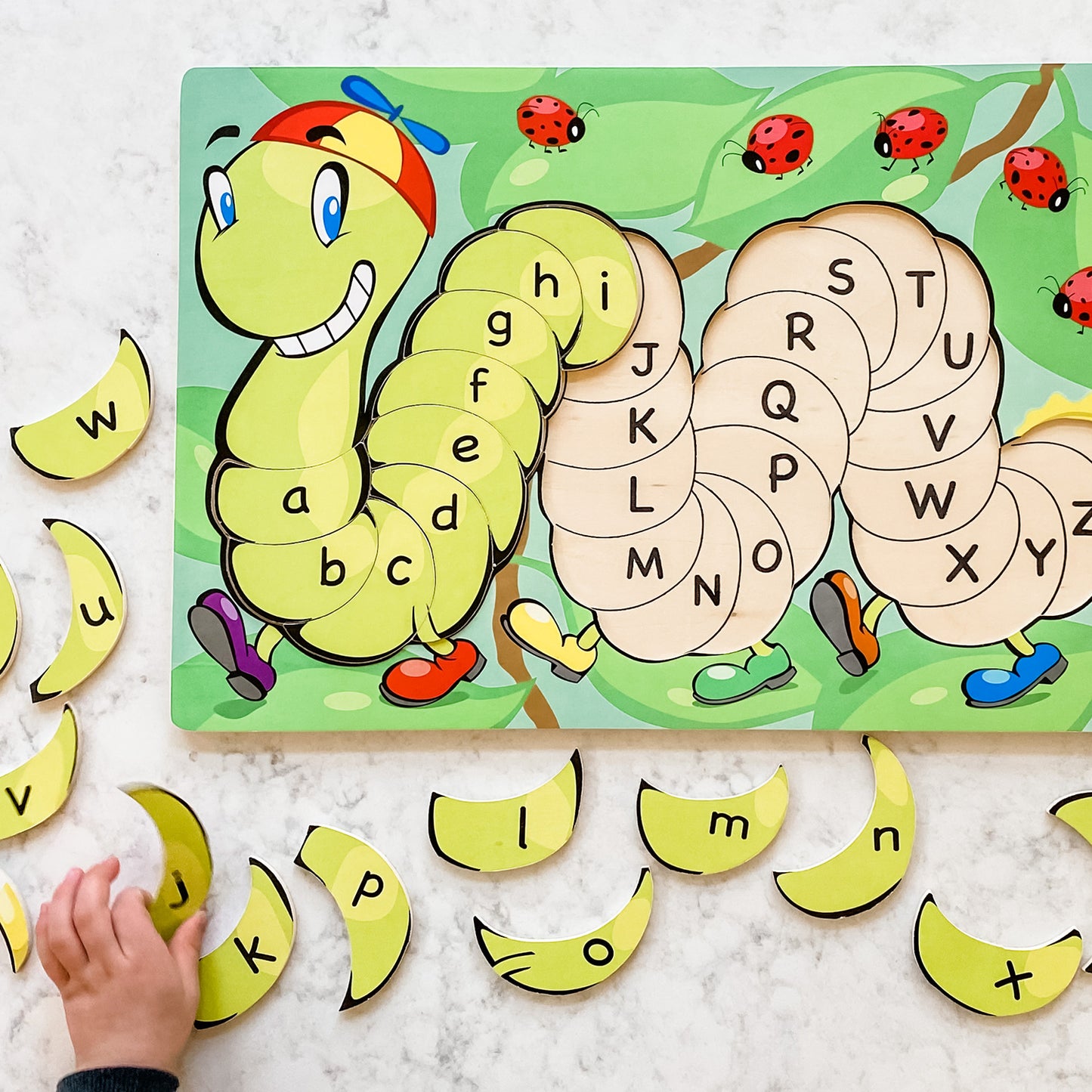
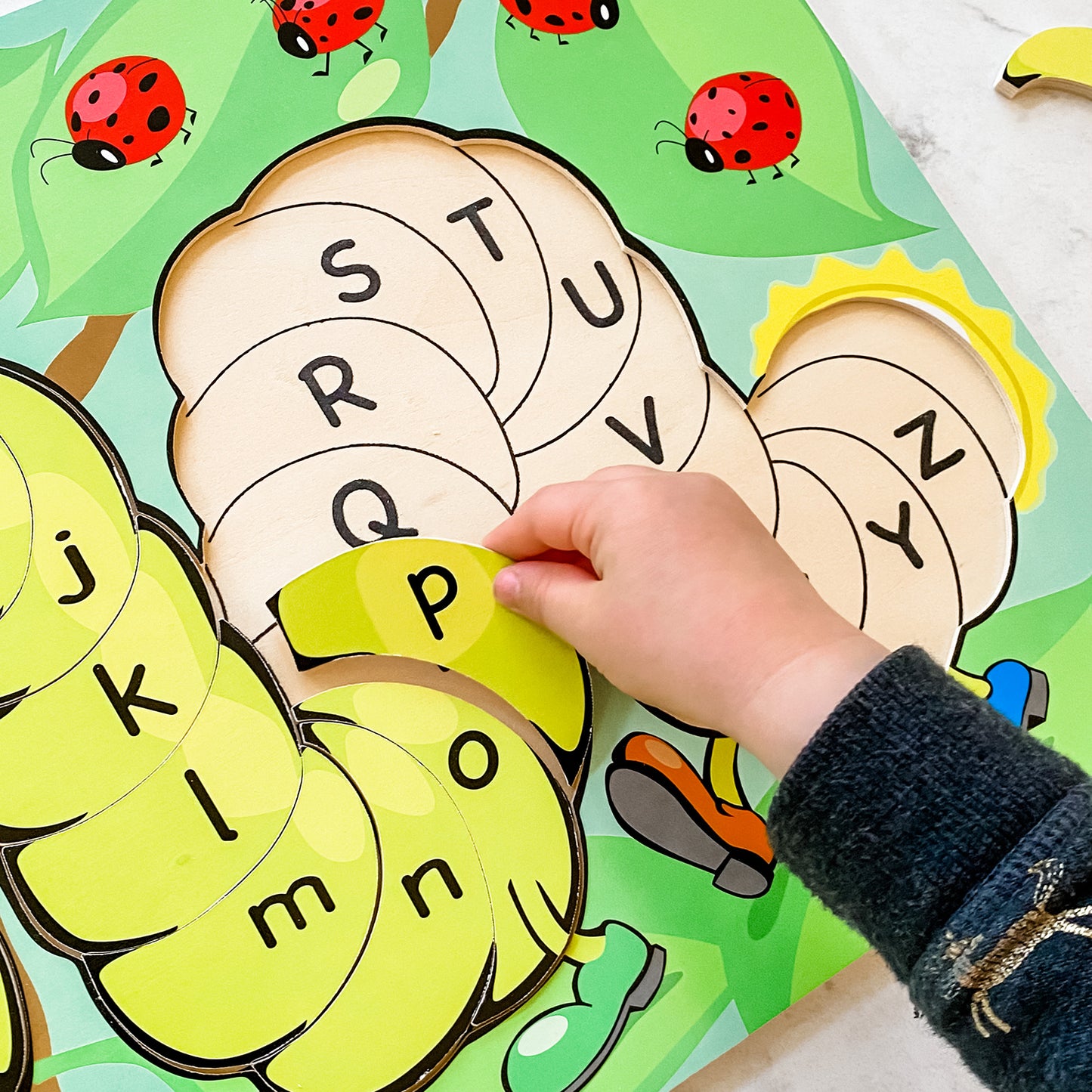
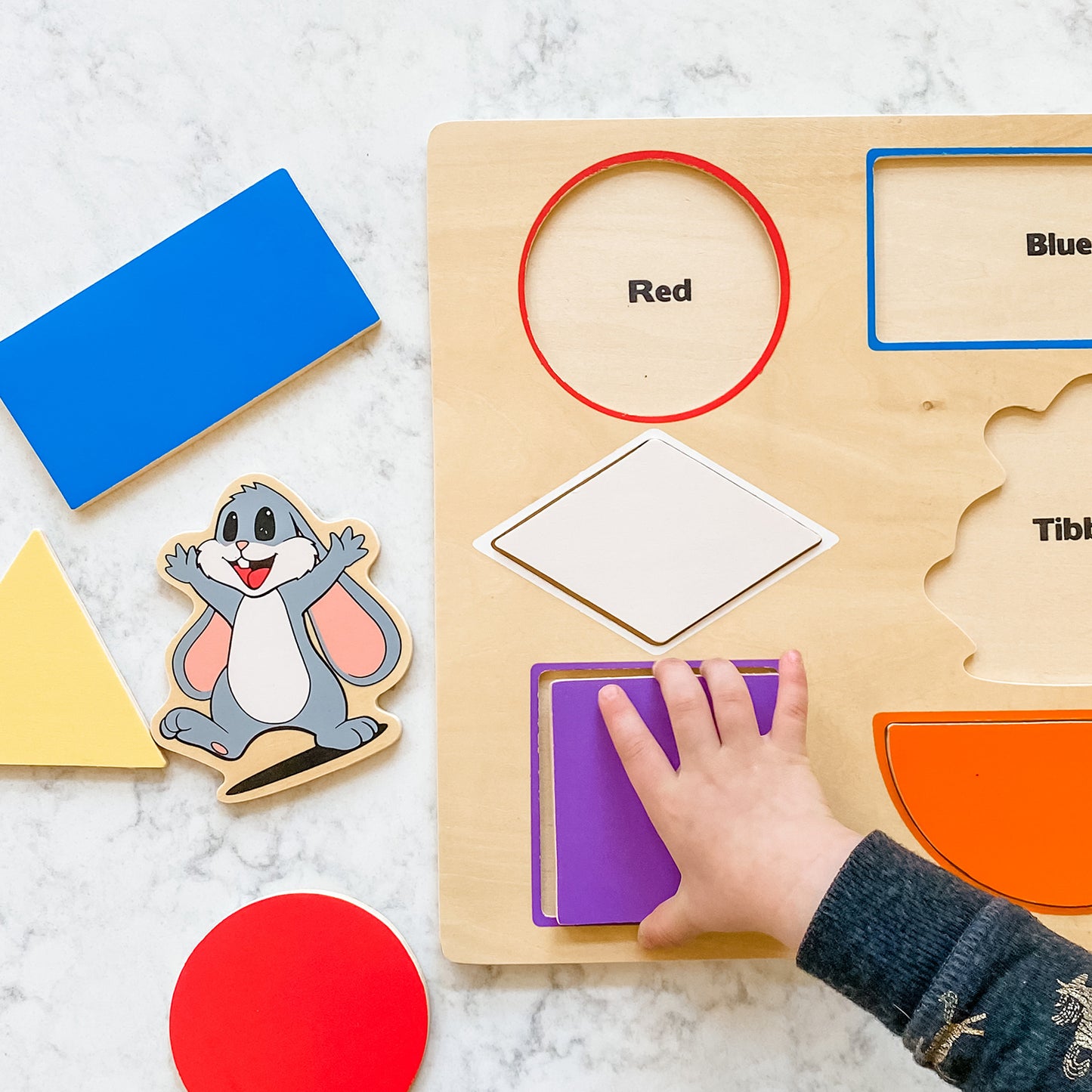
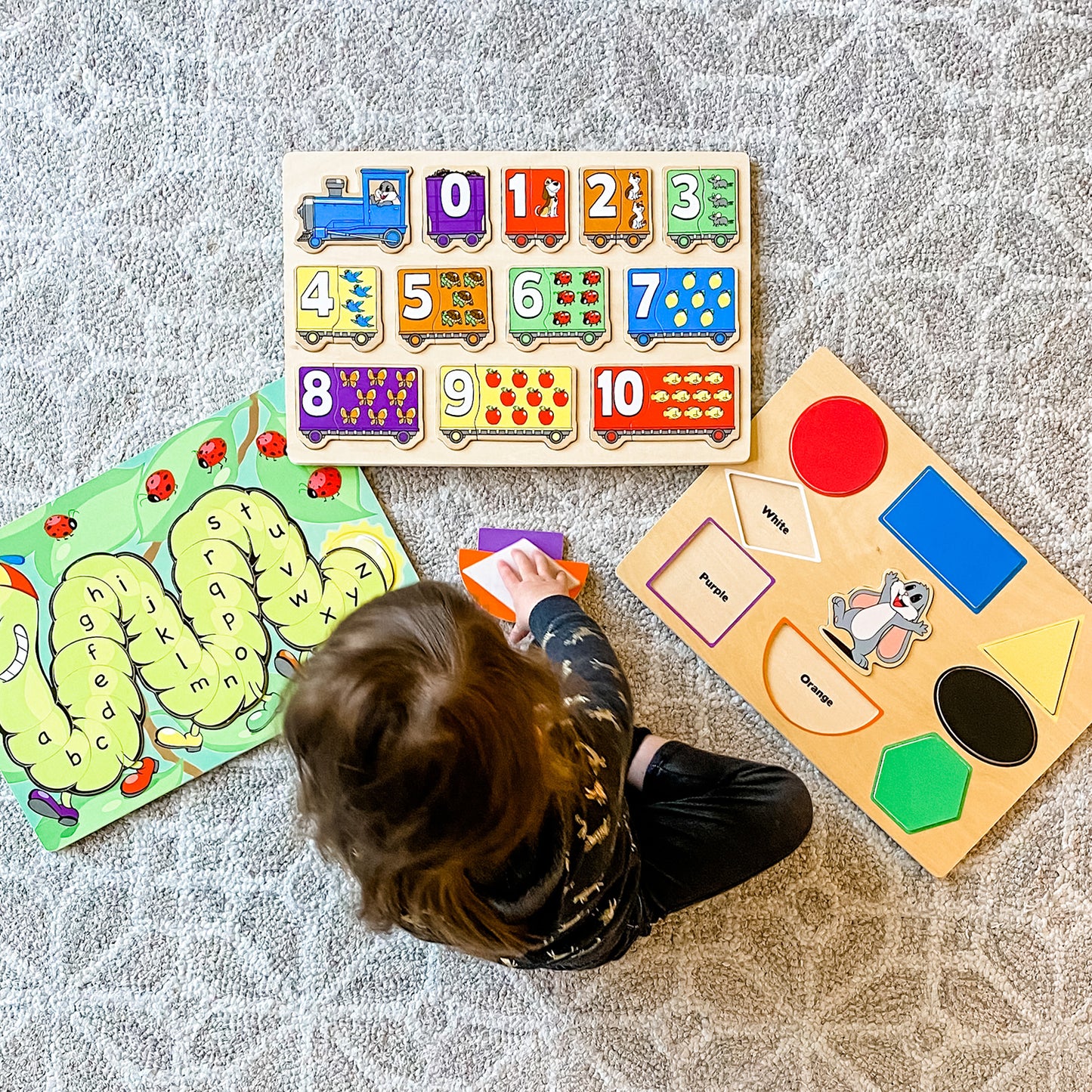
Collapsible content
How to Play
Educational Standards
Head Start*
Math
- Geometry & Spatial Sense
- Progresses in ability to put together and take apart shapes.
- Begins to be able to determine whether or not two shapes are the same size and shape.
- Shows growth in matching, sorting, putting in a series and regrouping objects according to one or two attributes such as color, shape or size.
- Patterns & Measurement
- Shows increasing abilities to match, sort, put in a series, and regroup objects according to one or two attributes such as shape or size.
- Begins to make comparisons between several objects based on a single attribute.
Science
- Scientific Skills & Methods
- Develops increased ability to observe and discuss common properties, differences and comparisons among objects and materials.
- Reasoning & Problem Solving
- Grows in recognizing and solving problems through active exploration, including trial and error, and interactions and discussions with peers and adults.
- Develops increasing abilities to classify, compare and contrast objects, events and experiences.
Core Standard*: Language, Math
Language
- Language
- Vocabulary Acquisition and Use. Grade Level K
Math
- Counting and Cardinality
- Know number names and the count sequence. Grade Level K
- Count to tell the number of objects. Grade Level K
- Compare Numbers. Grade Level K
- Geometry
- Identify and describe shapes. Grade Level K
Skills
Explore
What Does Child Do To Use Skill In The Game?
When putting the puzzle together, players need to explore the shapes and graphics of different pieces in order to see which may fit together.After puzzles are completed, players explore the completed image to look for plants, animals, vehicles, etc.
How Parents Can Assist Learning
To help children in building the puzzle, educators can encourage children to look closely at the piece they are trying to place. Children usually focus on the shape, the color, or the content on the piece. Determine what they are focusing on, and help them think about the other aspects as well. For instance, "Can you tell me how many sides the purple shape has?" or "What is your favorite animal on the train?" in order to prompt children to look at all the information on the puzzles closely.
Learning Implications and Educator Support
To help children in building the puzzle, educators can encourage children to look closely at the piece they are trying to place. Children usually focus on the shape, the color, or the content on the piece. Determine what they are focusing on, and help them think about the other aspects as well. For instance, "Can you tell me how many sides the purple shape has?" or "What is your favorite animal on the train?" in order to prompt children to look at all the information on the puzzles closely.
Determine
What Does Child Do To Use Skill In The Game?
Players must determine the characteristics of puzzle pieces based on shape, size, color and sometimes the information on the puzzle board. They also need to determine what locations on the puzzle could accommodate the puzzle piece.
How Parents Can Assist Learning
To help the youngest children, allow them to look at the images of the puzzles on the packaging so they can see how a puzzle looks when completed. Also, use directional language like above, below, next to, left and right to help children look for location to place a puzzle piece. Children many enjoy singing the ABC song while doing the Caterpillar puzzle. This song is great for learning the letters and their sequence.
Learning Implications and Educator Support
Tibbar's Little Hand Big Smiles puzzles involve a high degree of matching and spatial reasoning. To help the youngest children, allow them to look at the images of the puzzles on the packaging so they can see how a puzzle looks when completed. Also, use directional language like above, below, next to, left and right to help children look for location to place a puzzle piece.
Educators can also use the Train and Caterpillar puzzles to working on sequencing skills. After children complete the Caterpillar puzzle, sing the ABC song in celebration (and to help reinforce sequencing)!
Compare
What Does Child Do To Use Skill In The Game?
Players will compare shape of a puzzle piece with the open spaces on the puzzle board to determine where to place it.Players may also compare colors, numbers and objects on the train puzzle.
How Parents Can Assist Learning
On the Train puzzle, help children learn to match based on numbers and counting by encouraging them to count the objects on a train car (ex: four birds) and then find the number that corresponds (ex: the number 4). This builds one-to-one correspondence, or understanding of the word number in relation to the actual number of objects. This is critical as a foundation for math.
On the Caterpillar puzzle, parents can work with children to learn lower case and upper case letters. Point to an upper case letter on the puzzle board and ask the child to find the piece with the lower case letter.
Learning Implications and Educator Support
Manipulating, visually examining, and otherwise comparing shapes is important for young children to begin understanding geometry and spatial relations. There are several different matching skills involved in these puzzles, including number to amount, upper and lower case letters, and shape of piece to location on puzzle board.
On the Train puzzle, work with children on one-to-one correspondence. Have them match based on numbers and counting by encouraging them to count the objects on a train car (ex: four birds) and then find the number that corresponds (ex: the number 4).
On the Caterpillar puzzle, educators can work with children to learn lower case and upper case letters. Point to an upper case letter on the puzzle board and ask the child to find the piece with the lower case letter.
Remember
What Does Child Do To Use Skill In The Game?
Players may need to remember the relationship between a lower case and upper case letter for the caterpillar puzzle.
How Parents Can Assist Learning
The Caterpillar puzzle is great to teaching sequencing of the alphabet. Parents can help children think about what letter comes next in the alphabet in order to find the next puzzle piece. If children do not know their capital letters, draw the lower case letters on the puzzle itself, matching the lower case letters on the puzzle pieces as closely as you can.
Learning Implications and Educator Support
The Caterpillar puzzle is great to teaching sequencing of the alphabet. Educators can help children think about what letter comes next in the alphabet in order to find the next puzzle piece. If children do not know their capital letters, draw the lower case letters on the puzzle itself, matching the lower case letters on the puzzle pieces as closely as you can.
Experiment
What Does Child Do To Use Skill In The Game?
If a piece does not fit on the first attempt, a player may experiment with changing its orientation or location in order to find the right spot to place it.
How Parents Can Assist Learning
If a child has the correct piece but cannot get it to fit, show them how to change the orientation (ex: by turning 180 degrees) so that it will fit into the puzzle. The adult can cue the child by just saying, "Try another way."
Learning Implications and Educator Support
If a child has the correct piece but cannot get it to fit, show them how to change the orientation (ex: by turning 180 degrees) so that it will fit into the puzzle. The adult can cue the child by just saying, "Try another way."
Practice
What Does Child Do To Use Skill In The Game?
The more players engage with the puzzles, they will improve fine motor and comparison skills. This will allow them to more quickly assemble the puzzles.
How Parents Can Assist Learning
To encourage repeat play and practice, give children plenty of positive feedback for putting pieces in the correct location and completing puzzles correctly. Also, making the content relevant to the child's real-life experiences adds motivation to keep playing. For example, make some lemonade with the child with the #7 train car nearby. You can compare the lemons on the car and the real lemons, and then enjoy great tasting lemonade!
Learning Implications and Educator Support
To encourage repeat play and practice, give children plenty of positive feedback for putting pieces in the correct location and completing puzzles correctly.
Solve
What Does Child Do To Use Skill In The Game?
Players solve the puzzle by putting all the pieces in the proper location.
How Parents Can Assist Learning
To help younger children, allow them to look at the packaging so they can see if they placed the piece in the correct location. Children will also solve the puzzle through trial and error. This should be encouraged, as children need to learn to persist in solving a problem.
For the next level encourage children to identify and name what is on a puzzle piece, then ask what would go with it? This encourages the child to develop a strategy rather than using trial-and-error.
Learning Implications and Educator Support
To help younger children, allow them to look at the packaging so they can see if they placed the piece in the correct location. Children will also solve the puzzle through trial and error. This should be encouraged, as children need to learn to persist in solving a problem.
For the next level encourage children to identify and name what is on a puzzle piece, then ask what would go with it? This encourages the child to develop a strategy rather than using trial-and-error.
Demonstrate
What Does Child Do To Use Skill In The Game?
Players may demonstrate if encouraged. See Implications for Learning and Adult Support.
How Parents Can Assist Learning
For the train puzzle, adults can ask children to show them how they figured out which number goes with which set of objects. For the Caterpillar puzzle, have a child select a tile and then point to the capital letter on the puzzle board to show their knowledge of capital and lower case letter relationships.
Learning Implications and Educator Support
For the train puzzle, adults can ask children to show them how they figured out which number goes with which set of objects. For the Caterpillar puzzle, have a child select a tile and then point to the capital letter on the puzzle board to show their knowledge of capital and lower case letter relationships.
Imagine
What Does Child Do To Use Skill In The Game?
Children may use imagination if encouraged. See Implications for Learning and Adult Support.
How Parents Can Assist Learning
To stimulate their imaginations, ask children to imagine where the train might be going, where the caterpillar lives or what the shapes and colors make them think or feel.
Learning Implications and Educator Support
To stimulate their imaginations, ask children to imagine where the train might be going, where the caterpillar lives or what the shapes and colors make them think or feel.
Create
What Does Child Do To Use Skill In The Game?
Children may be creative if encouraged. See Implications for Learning and Adult Support.
How Parents Can Assist Learning
Make up stories with children that involve the different objects and images on the puzzles.
Learning Implications and Educator Support
Make up stories with children that involve the different objects and images on the puzzles.
*Data compiled from CCSSI ELA Standards, WA Science Standards, and Washington Social Studies Standards
Special Needs
Cognitive
Suggestions for How to Modify Play Experience
For children with lower cognitive skills, start with the shape puzzle, then move to the numbers, then the letters. This will help them learn shape matching from easy to harder.
Letter puzzle modification: For children with lower functioning skills, matching the lower case and capital letters may be difficult. Many lower case letter will look different than the capital letters beneath them. If children have difficulty with this aspect, use a marker to write a lower case letter next to the capital letter.
Communication
Suggestions for How to Modify Play Experience
Shape puzzle modification: As a child places a puzzle piece, ask them to tell you something about the shape. They can name the shape, but ask for more information. For example, "How many sides does it have? How many corners?" "How many sides are long? How many short?"
Number puzzle modification: Make up stories about where the train is going. Why is it going there? Why are the different animals and fruit on the train? For instance, "My favorite train car has six lady bugs in it. We're taking them to a fairy garden. The fairy's name is Isabella the Flower Fairy." This modification will encourage children to talk, ask each other questions, and expand their own stories. Children should be encouraged to imagine and create inventive stories.
Sensorimotor
Suggestions for How to Modify Play Experience
Alphabet puzzle modification: For children with fine motor concerns, the alphabet puzzle is not appropriate as the pieces must be fitted exactly.
Social Emotional/Behavioral
Suggestions for How to Modify Play Experience
Number and alphabet puzzle modifications: Take turns adding a pieces. For the train, one child can add the number pieces and another can add the matching piece with the animals or fruit. Or, children can collaborate to put the train together in numerical order. For the letter puzzle, take out all the pieces and then the children pick and put it in the correct locations. Then the work together to place the next letter going forward (ex: M is after L). After reaching Z, they work together to put letters in sequence backwards (ex: K goes before L). Additionally, since the lower case and capital letters may not exactly match, the children can help each other.
Number puzzle modification: Make up stories about where the train is going. Why is it going there? Why are the different animals and fruit on the train? For instance, "My favorite train car has six lady bugs in it. We're taking them to a fairy garden. The fairy's name is Isabella the Flower Fairy." This modification will encourage children to talk, ask each other questions, and expand their own stories. Children should be encouraged to imagine and create inventive stories.
Vision
Suggestions for How to Modify Play Experience
The alphabet puzzle is not appropriate for children with low vision.
Number puzzle modification: For children with low vision, take out one half of the each puzzle set, such as all the puzzle pieces with a number. This will help children see the missing shape.
Hearing
Suggestions for How to Modify Play Experience
All children should be able to complete the puzzles.
*Data compiled from CCSSI ELA Standards, WA Science Standards, and Washington Social Studies Standards
Autism
Autism Special Considerations
Appears to ignore other's communication and/or has difficulty giving eye contact to a communication partner
Is This Game Appropriate for Child with Characteristic? Yes
Can Child with Characteristic Play Game w/o Modification? Yes
Strategies for Developing Compensatory Skills:
This is primarily an individual activity, though it can be made into a turn taking game.
Has difficulty understanding complex verbal directions
Is This Game Appropriate for Child with Characteristic? Yes
Can Child with Characteristic Play Game w/o Modification? Yes
Strategies for Developing Compensatory Skills:
Combine short verbal instructions with visual and physical examples of each step. For example give the child pieces first for the shape puzzle, as this is the easiest. For the number puzzle, start will the numbers removed from the puzzle slots and let the child find the matching number. The reverse the parts removed. Finally, remove all pieces. Use photos from the box to illustrate what needs to be done. For the alphabet puzzle, begin with most of the pieces in place, once the child understand the process, remove more pieces. Having to place fewer pieces while learning helps children feel successful, reduces frustration, and helps them learn without feeling overwhelmed.
Use hand-over hand guidance if needed, so children feel the actions as the directions are being given. This helps develop the child's memory for the correct movements. Gradually reduce the support as children learn how to try different orientations with the pieces.
Uses vocabulary inaccurately or demonstrates echolalia (repeating another's speech)
Is This Game Appropriate for Child with Characteristic? Yes
Can Child with Characteristic Play Game w/o Modification? Yes
Strategies for Developing Compensatory Skills:
Provide correct labels for words when incorrect labels are stated by the child.
Respond to immediate echolalia (repeating what was just said) by rephrasing the child's response into a correct format, so the child can hear and repeat that phrase. For example, assume you are playing with a child named Andy and you say, "Your turn," and Andy repeats, "Your turn." You can say, "It's Andy's turn. You say, my turn." This allows the child to hear and repeat the correct response. Eventually, the child will pick up the pattern of response.
Delayed echolalia (repetition of previously heard comments) may have a hidden meaning or association. Look for connection in the phrase used to the current situation. For example, the child says, "After these messages we'll be right back!" Think what the repeated phrase is associated with for the child. Try to interpret what is meant and rephrase it for the child. For example, you might respond by saying, "It sounds like you want a break for a few minutes. Is that what you mean? You can tell me, 'I need a break.'"
Gets stuck repeating a verbal topic or physical actions and/or has difficulty attending to others' actions or topic.
Is This Game Appropriate for Child with Characteristic? Yes
Can Child with Characteristic Play Game w/o Modification? No
Strategies for Developing Compensatory Skills:
Incorporate a preferred topic into the game to increase motivation. For example, if the child is fixated on a particular character, like a favorite super hero, ask what the character would do if they were playing with the puzzle?
Extend the child's action to make a correct response. For example, if the child places a piece correctly, say, "That's right. Try another piece."
Has difficulty producing speech/communication
Is This Game Appropriate for Child with Characteristic? Yes
Can Child with Characteristic Play Game w/o Modification? Yes
Strategies for Developing Compensatory Skills:
Communication is not needed for this activity.
Has difficulty sequencing multi-step actions and/or doing complex abstract tasks
Is This Game Appropriate for Child with Characteristic? Yes
Can Child with Characteristic Play Game w/o Modification? Yes
Strategies for Developing Compensatory Skills:
Encourage children to persist to completion of the puzzle. Reinforce after correct placement of three pieces.
Demonstrates difficulty initiating and maintaining social interactions
Is This Game Appropriate for Child with Characteristic? Yes
Can Child with Characteristic Play Game w/o Modification? Yes
Strategies for Developing Compensatory Skills:
No social interaction is required.
Acts out or demonstrates avoidance behaviors when frustrated, overwhelmed, or needs more sensory input.
Is This Game Appropriate for Child with Characteristic? Yes
Can Child with Characteristic Play Game w/o Modification? No
Strategies for Developing Compensatory Skills:
Reduce extraneous noise or allow the child to wear head phones or ear plugs if loud sounds cause anxiety.
A weighted vest worn during the game may provide additional pressure input and thus reduce fidgeting due to sensory needs. Pressure can be calming when used for no more than 20 minutes at a time.
Practice a phrase to ask for help and role play situations in the game where it is needed.
Provide techniques for self-calming, such as holding a special toy.
Allow time for movement. For example, a child who needs to move frequently can be given an opportunity to 'celebrate' their turn by running around the table or jumping up and down 10 times.
Has short attention span for non-preferred activities
Is This Game Appropriate for Child with Characteristic? Yes
Can Child with Characteristic Play Game w/o Modification? Yes
Strategies for Developing Compensatory Skills:
Provide a break when needed.
Use "when...then" phrases. For example, "When you get three pieces in, then I'll let you play with your toy."
Frequently remind the child of the goal of the game. " You are putting all the pieces in to make a picture ."
Needs sameness or consistent routines and/or has difficulty with transitions from one activity to another
Is This Game Appropriate for Child with Characteristic? Yes
Can Child with Characteristic Play Game w/o Modification? No
Strategies for Developing Compensatory Skills:
Play games at the same time every day, so the child anticipates the game routine.
Change the location of the game, so the child may play in different rooms, at the table, or on the floor. This will build tolerance for variation.
Prepare the child ahead time for the introduction of a new game. Talk about aspects that will be motivating for the child, and let them explore the parts of the game before setting out the whole game. Provide a structure for placement of game pieces that can be the same each time the game is played. For example, have a specific location for where the board goes, the pieces, etc.
Use an object cue. Let the child hold an object from the game or activity you want to introduce prior to the transition. For example, give the child a puzzle piece and say, "Let's go find the puzzle this goes with."
Has difficulty understanding others' feelings, intentions, and the reasons for others' actions.
Is This Game Appropriate for Child with Characteristic? Yes
Can Child with Characteristic Play Game w/o Modification?
Strategies for Developing Compensatory Skills:
Ask child to explain their own feelings and intentions.
*Data compiled from CCSSI ELA Standards, WA Science Standards, and Washington Social Studies Standards
Extended Play
Extra Ways to Play the Game
Number puzzle: Children need to learn that when counting objects, the last number they say is the total amount of objects. To do this with this game, remove all of the puzzle pieces and spread them out on the table randomly. Have each child in turn pick a piece with animals or fruits on it. Have them count the objects on the puzzle, making sure the child is using one-to-one correspondence and counting all objects. Then ask the child, for example, "How many apples do you have?" If the child answers correctly, ask the child to find the matching number and then put the two pieces in the big board. If the child answers incorrectly, tell the child, "The last number you count is how many you have." Repeat the count and ask the same question. It may take several tries for the child to understand.
Materials Needed
No additional materials needed.
Developmental Benefits
This expansion helps children learn the meaning of "how many" or "total" or "all together." This is the foundation of learning to add and subtract.
Extra Ways to Play the Game
Number puzzle: Each player takes two numbers and their picture halves and makes up a story. For example, "One dog chased two cats, how many animals were running all together?" The next child has to answer by picking the right number. Encourage children to use their fingers to count. Put all pieces back in the board. The next child makes up a story with two numbers, and so on moving to the left each time.
Materials Needed
No additional materials needed.
Developmental Benefits
This expansion demonstrates that adding is really "counting on" from one set to another. This concept is a fundamental math skill. Although children just think they are counting totals, they are building the foundation for adding and subtracting.
Extra Ways to Play the Game
Alphabet puzzle: Take the puzzle pieces out. Each player in turn picks up a letter and says a word that starts with that letter. If correct the player places the letter in the right spot on the puzzle. If wrong the letter goes back to the center. The goal is to complete the puzzle together. It is okay to help each other!
Materials Needed
No additional materials needed.
Developmental Benefits
This expansion helps children learn sound-letter correspondence for each letter of the alphabet. Learning initial sounds also helps children beginning learning to read from left to right and to start sounding out words.
Extra Ways to Play the Game
Alphabet puzzle: Write down family names on pieces of paper. Children then try to find the letters in each name, one at a time. If there is a double letter, the child just repeats the letter. For example, "Daddy, d-a-d-d-y. There are 3 d's in daddy." The child would just remove d, a, and y. Write down other favorite words, if desired. Adults should make the sound of each letter so the child hears how the letter sounds string together.
Materials Needed
Paper and pencil.
Developmental Benefits
Children are motivated to learn to spell and write names first. This games helps children match letters and learn sound-letter associations with words they want to learn to write. They also learn that some words have more than one of the same letter in it.
*Data compiled from CCSSI ELA Standards, WA Science Standards, and Washington Social Studies Standards
Collapsible content
How to Play Video & Transcript
In this session, we’ll share Tibbar’s Little Hands, Big Smiles, a Simply Fun three-puzzle set that introduces toddlers and preschool aged children to basic shapes, colors, letters of the alphabet and numbers 1 through 10.
Tibbar’s Little Hands, Big Smiles is ideal for ages 3 and up, and helps little ones learn pre-school ready skills and gain self-confidence while they play!
Tibbar’s Little Hands, Big Smiles includes:
• Tibbar’s First Shapes and Colors Puzzle,
• Huey Alphabet Puzzle, and,
• Tibbar’s Number Train Puzzle
There are lots of fun and educational activities your toddler or preschooler can play with Tibbar’s Little Hands, Big Smiles puzzle set.
With Tibbar’s First Shapes and Colors Puzzle, your child will learn to identify and match simple geometric shapes and primary colors. Note the extra feature of the color name printed on the puzzle board under each shape.
With the Huey Alphabet Puzzle, they will learn to recognize both upper and lower case letters of the alphabet – matching the lower case puzzle pieces to the upper case letters printed on the puzzle board.
With Tibbar’s Number Train Puzzle, they will identify and count the numbers from 1 to 10 – matching the numeric symbol to a representative count of colorful, amusing items in the same train car.
Notice how each train car is broken into two segments, one with the number, and one with the item count. In addition to matching the pieces and learning number order, children can see how representative symbols can “add up” to the number.
The three puzzles together give your child a well-rounded primer of shapes, colors, letters and numbers.
Tibbar’s Big Hands, Little Smiles is a great way to introduce young learners to foundational early learning concepts that prepare them to enter school with confidence!

